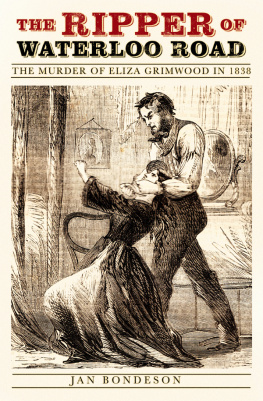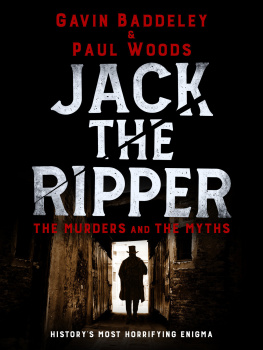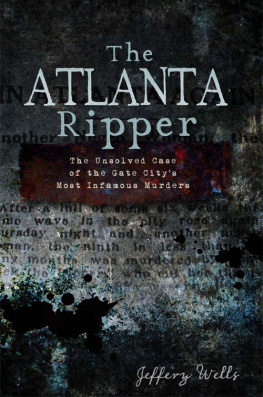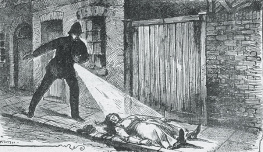THE RIPPER OF
WATERLOO ROAD

First published in 2017
The History Press
The Mill, Brimscombe Port
Stroud, Gloucestershire, GL5 2QG
www.thehistorypress.co.uk
This ebook edition first published in 2017
All rights reserved
Jan Bondeson, 2017
The right of Jan Bondeson to be identified as the Author of this work has been asserted in accordance with the Copyright, Designs and Patents Act 1988.
This ebook is copyright material and must not be copied, reproduced, transferred, distributed, leased, licensed or publicly performed or used in any way except as specifically permitted in writing by the publishers, as allowed under the terms and conditions under which it was purchased or as strictly permitted by applicable copyright law. Any unauthorised distribution or use of this text may be a direct infringement of the authors and publishers rights, and those responsible may be liable in law accordingly.
EPUB 978 0 7509 8186 6
Original typesetting by The History Press
eBook converted by Geethik Technologies
CONTENTS
FOREWORD
Back in 2006, I purchased, through the medium of eBay, a handsomely leather-bound set of the New Newgate Calendar, a scarce penny dreadful issued in weekly parts from October 1863 until March 1865. Its two volumes are full of lurid accounts of celebrated criminals, like the mariticidal Catherine Hayes who ended her days being burnt at the stake, William Corder who murdered Maria Marten in the Red Barn, the gamblers Thurtell and Hunt who murdered William Weare at Gills Hill Cottage, and Mother Brownrigg who tortured and killed her young apprentice girls. Each penny issue has a gory frontispiece depicting some unfortunate individual being stabbed, shot or disembowelled; women are ravished, flogged or thrown out of carriages, and the sadistic Mother Brownrigg advances on her helpless, half-naked victim, whip in hand.
Issues 53 to 61 of the New Newgate Calendar contain another thrilling tale: Eliza Grimwood, or the Mysteries of Crime, beginning with the highly charged words:
Murder!
How the horrible sound rings in the night air.
Murder!
What a thrill of horror darts through the frame of the cry. What atrocity what crime is conveyed in the sentence. The poor, ghastly, bleeding victim, with glazed eyes and livid features, launched into eternity with frightful suddenness What horror, what agony must be endured by the victim of the assassins knife.
Murder! Murder!
The horrible cry wakes up the stillness of the night with dreadful effect. Such a cry was taken up from mouth to mouth one bright summer night in July 1838, in the locality of the Waterloo Road On the night in question an awful and atrocious murder was committed on a weak, frail woman a wretched creature of the town was cruelly and barbarously murdered with more than usual atrocity.
Although the account in the New Newgate Calendar is full of exaggerations and inaccuracies, it rightly states that the Ripper of Waterloo Road with fiendly [sic], devilish and horrible atrocity, had inflicted the most hideous and diabolical injuries to the body of the wretched girl, abusing it in a manner that dare not be described.
I decided to investigate the unsolved 1838 murder of Eliza Grimwood further, spending ten years gathering material for this book. For the researcher or genealogist, it will be a welcome reminder that even what may be perceived as a relatively insignificant historical episode has generated considerable amounts of contemporary and secondary documentation, making it possible to tell the dramatic and exciting murder story as if Eliza Grimwood had been done to death just a few years ago. Well-nigh uniquely for a crime of that period, the diary of the police officer leading the investigation has been preserved for posterity. This means that the murder of Eliza Grimwood can be viewed from a triple perspective: that of the police, that of the contemporary newspapers, and that of its impact on popular culture and tradition. Why did the murder of Eliza Grimwood arouse such intense feelings of revulsion and outrage at the time? What was it about the sexually sadistic murder of a beautiful young prostitute that fascinated people at the time? What was the ultimate fate of Eliza Grimwoods restless spirit, said to have haunted the Waterloo Road murder house for many decades? And what can be deduced about the identity of the perpetrator, and how many victims did this proto-Ripperine Victorian man of blood really claim?
1
THE STAGE IS SET: LONDON IN 1838
In the year 1838, London was the greatest city in the greatest empire on the globe, and its inhabitants were ruled by the benign presence of the youthful, virginal Queen Victoria.
The youthful Queen Victoria was fond of her old governess, Baroness Lehzen, who maintained a benign influence over her young charge. Although this formidable German lady had no formal position at court, she enjoyed a good deal of influence in royal circles. Queen Victorias relations with her mother, the intriguing and unpopular Duchess of Kent, had always been problematic. Although the duchess was allowed to keep her apartments at Buckingham Palace, Victoria dismissed her mothers private secretary (and probable lover), the Irish adventurer Sir John Conroy. Lord Melbourne, the Whig prime minister, was a father figure to the orphaned young queen. A clever, educated gentleman, he dazzled her with his sparkling conversation and delighted her with his flattery. This experienced statesman was instrumental in helping her break free from the unwholesome influence of her mother and Conroy, and he did his best to guide her steps in matters of state after her accession to the throne. Queen Victoria was fond of simple pursuits, like counting the Canalettos in the Buckingham Palace picture galleries together with Baroness Lehzen (there were forty-three of them), amusing herself with puzzles and jigsaws, putting dissected pictures back together with the assistance of Lord Melbourne and Lord Conyngham, or watching her beloved spaniel Dash frolic in the palace grounds.

The young Queen Victoria, from Vol. 2 of the Gallery of Engravings.

Another engraving of the young Queen Victoria, from a portrait by Dalton after F. Winterhalter.
Queen Victorias household at Buckingham Palace was run to medieval standards by a number of inert functionaries, who jealously protected their ancient privileges, and resented trespass into the customary preserves of their departments. The office of the Lord Chamberlain provided lamps, that of the Lord Steward cleaned and trimmed them, and that of the Master of the Horse made sure they were lit. The insides of the Buckingham Palace windows were cleaned by the Lord Chamberlains department, the outsides by the Office of Woods and Forests; the cleaning was never performed simultaneously, meaning that Victoria had to gaze through windows that were translucent only. The average age of the royal servants was high; they had been employed through a corrupt grace and favour system, and stayed in service until well past normal retirement age. No person took responsibility for royal security, since it was considered well-nigh unthinkable that any person would have intent to harm or injure the queen. It would take the depredations of Queen Victorias persistent young stalker, Edward the Boy Jones, who stole her underwear and spied on her in the dressing room, lying underneath a sofa, and the pistol-toting would-be royal assassin Edward Oxford, who fired at the queen in her carriage, for royal security to be upgraded at long last.
Next page















